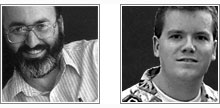What is View Productions?

View*Productions was founded in 1997 by Michael Kaplan and Gregory Terry to document and publish great works of architecture using stereoscopic photography.
Michael Kaplan is Professor of Architecture, Emeritus at the University of Tennessee, Knoxville, where he taught architectural design and theory. Winner of the AIA Education Honors Award in 1991, he is a licensed architect and has lectured and published widely on cultural aspects of architecture. A veteran stereo photographer, his lecture on the history, theory and practice of 3-dimensional architectural photography has been presented at venues throughout the United States.
Gregory Terry is a graduate of the University of Tennessee School of Architecture. He received a Master of Architecture with Graphic Design concentration from North Carolina State University, winning the Bronze Medal for the most outstanding School of Design thesis entitled “A Center for View-Master Technology.” Greg is a freelance architect Doing Stuff in Knoxville, TN.
